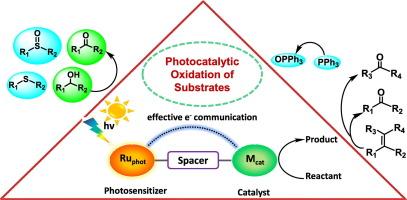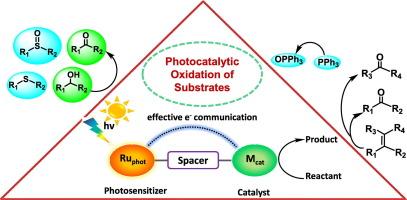使用多核 Ru(II)- 聚吡啶络合物光催化氧化各种有机底物
IF 20.3
1区 化学
Q1 CHEMISTRY, INORGANIC & NUCLEAR
引用次数: 0
摘要
在过去的几年里,过渡金属配合物作为光活性 SET(单电子转移)剂在有机合成化学中的广泛应用,为重塑已知的有机转化打开了新的大门,也为以前无法实现的反应产物开辟了不同的途径。特别是 Ru(II)-聚吡啶复合物,由于其三重激发态参与各种光活性的固有优势,已成为一种支柱。虽然无机界对 Ru(II)配合物的光物理已经有了很好的记载,但对于有机合成化学家感兴趣的问题,对它们的利用却较少。该领域的最新发展表明,有机合成与光活性金属配合物之间的联系可能会为这两个研究领域带来成功的结果。值得注意的是,与单核 Ru(II)- 聚吡啶配合物的严格应用相比,多核种类的研究较少,对其基本光电特性和应用的探索也相对不足。然而,与单核类似物相比,多核 Ru(II) 复合物通过对桥配体和/或单个金属中心的微调,提供了更有前景的光物理特性。最近,这类物种在光催化、发光器件(LED)、光动力疗法(PDT)、智能材料、光学传感器等研究领域取得了重大突破。在本研究中,我们概述了多核 Ru(II)- 聚吡啶配合物的光物理,旨在解释它们的基态和激发态特征,以及相关的光驱动电子/能量转移过程,以实现对各种有机底物(如醇、硫化物、烯等)的潜在催化氧化。本文章由计算机程序翻译,如有差异,请以英文原文为准。


Photocatalytic oxidation of various organic substrates using multinuclear Ru(II)-polypyridyl complexes
Over the past few years, an extensive usage of transition metal complexes as photoactive SET (single electron transfer) agents in the synthetic organic chemistry has opened new doors to reinvent the already known organic transformations as well as to create different paths for previously unattainable reaction products. Especially, Ru(II)-polypyridyl complexes have acted as a pillar owing to an inherent advantage of their triplet excited-state involved in various photoactivities. Though the photophysics of Ru(II) complexes has been well documented within inorganic community, they are less exploited for the problems of interest to the synthetic organic chemists. Recent development in this field suggests that a connection between organic synthesis and photoactive metal complexes might lead to successful outcomes in both the research areas. Notably, in contrast to the rigorous employment of mononuclear Ru(II)-polypyridyl complexes, the multinuclear species have been less well-studied and their fundamental optoelectronic properties and applications are relatively under explored. However, the multinuclear Ru(II) species offer more promising photophysical features compared to the mononuclear analogues via fine-tuning of the bridging ligands and/or the individual metal centres. Recently, such species have enabled essential breakthroughs in the research fields of photocatalysis, light-emitting devices (LEDs), photodynamic therapy (PDT), smart materials, optical sensors and so on. In this study, we offer an overview of the photophysics of multinuclear Ru(II)-polypyridyl complexes with an aim to explain their ground- and excited-state features, along with related light-driven electron/energy transfer processes for potential catalytic oxidation of various organic substrates such as alcohols, sulfides, alkenes, etc.
求助全文
通过发布文献求助,成功后即可免费获取论文全文。
去求助
来源期刊

Coordination Chemistry Reviews
化学-无机化学与核化学
CiteScore
34.30
自引率
5.30%
发文量
457
审稿时长
54 days
期刊介绍:
Coordination Chemistry Reviews offers rapid publication of review articles on current and significant topics in coordination chemistry, encompassing organometallic, supramolecular, theoretical, and bioinorganic chemistry. It also covers catalysis, materials chemistry, and metal-organic frameworks from a coordination chemistry perspective. Reviews summarize recent developments or discuss specific techniques, welcoming contributions from both established and emerging researchers.
The journal releases special issues on timely subjects, including those featuring contributions from specific regions or conferences. Occasional full-length book articles are also featured. Additionally, special volumes cover annual reviews of main group chemistry, transition metal group chemistry, and organometallic chemistry. These comprehensive reviews are vital resources for those engaged in coordination chemistry, further establishing Coordination Chemistry Reviews as a hub for insightful surveys in inorganic and physical inorganic chemistry.
 求助内容:
求助内容: 应助结果提醒方式:
应助结果提醒方式:


